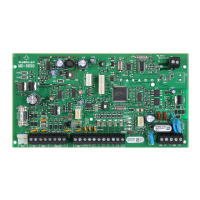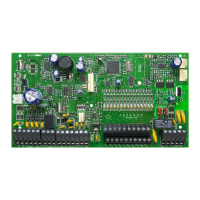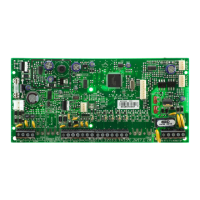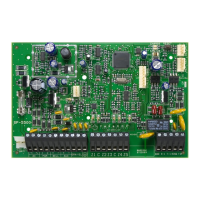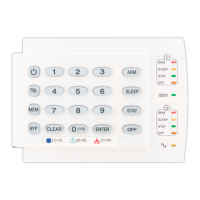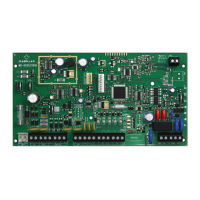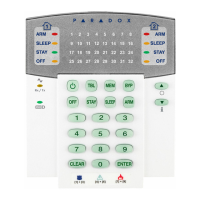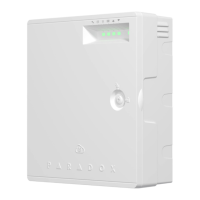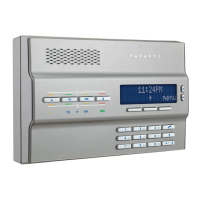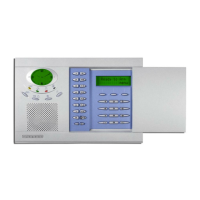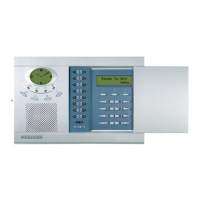Do you have a question about the Paradox MG5050+ and is the answer not in the manual?
| Partitions | 2 |
|---|---|
| PGMs | 16 |
| Wireless Zones | 32 |
| StayD Mode | Yes |
| Number of Zones | 32 |
| Wireless | Yes |
| Remote Control | Yes, via remote controls and app |
| Power Supply | 16.5 V AC |
| Battery Backup | 7Ah |
| Zones | 32 (8 on-board) |
Details on product warranty terms and conditions available on the Paradox website.
Understanding the limitations of alarm systems for comprehensive protection and risk reduction.
Guide on using the MG5050+ programming guide with the reference and installation manual.
Explanation of typographical conventions used in the programming guide for clarity.
Installer, maintenance, and system master codes for accessing and controlling the panel.
Procedures for resetting the panel to its default settings.
Step-by-step guide to enter programming mode and navigate through sections.
Methods for entering data, including single digit and feature select programming.
How to enable/disable specific features using keypad options.
Procedure to view panel and keypad version numbers.
Guide to entering decimal and hexadecimal values for programming.
Programming requirements for achieving EN 50131 compliance.
Reference to worksheets for planning and recording system settings.
Assigning and enrolling zones, including wireless zones and partition assignment.
Programming entry and exit delays, and bell cut-off times.
Setting the system's time, date, and time format.
Procedures for entering and managing installer and maintenance codes.
Configuration settings for BabyWare software, including phone number and panel ID.
Setting the monitoring station phone number and account information.
Configuring communicator settings for personal phone numbers.
Assigning zones to keypads and programming PGM functions and delays.
Assigning entry point zones for StayD mode functionality.
Worksheet for planning bus modules and their path zone assignments.
Worksheet for planning wireless keypads and their path zone assignments.
Worksheet for planning wireless sirens.
Worksheet for planning programmable outputs (PGMs) and their assignments.
Worksheet for planning wireless repeaters.
Worksheet for planning zones, including arming methods.
Information on how the control panel recognizes zones, including expansion modules.
How to define zones on the MG5050+ control panel using zone definitions and partition assignments.
Creating custom zone definition templates to overwrite default definitions.
Programming zone timers for response times and other delays.
Programming wireless zones by entering serial numbers or using the LEARN/TAMPER switch.
Testing the signal strength of wireless transmitters using beep indicators.
Programming report codes and labels for each zone.
Recording and programming labels for each zone.
Programming programmable outputs (PGMs) and recognizing their functions.
Detailed list of event groups, sub-groups, and their descriptions for system reporting.
Recording and programming PGM activation/deactivation events and their partitions.
Recording and setting PGM delay values for activation/deactivation events.
Recording wireless PGM serial numbers for assignment and deletion.
Viewing signal strength for wireless PGMs using beep indicators.
Recording and setting labels for PGMs.
Recording and managing installer, maintenance, and system master codes.
Configuring user code options for partition access, arming, and other features.
Recording and setting user report codes for system events.
Recording and setting labels for users.
Assigning wireless repeaters to the control panel and recording serial numbers.
Recording and setting labels for wireless repeaters.
Automatic and standard assignment of wireless keypads to the control panel.
Configuring supervision and other options for wireless keypads.
Testing and viewing signal strength for wireless keypads.
Recording and setting labels for wireless keypads.
Programming remote controls and assigning functions to their buttons.
Assigning remote controls to users and managing their assignments.
Assigning wireless sirens, checking signal strength, and setting labels.
Procedure to cancel tamper supervision for wireless sirens.
Detailed description of partition, general system, keypad, and arming/disarming options.
Configuring tamper recognition and supervision options for zones.
Setting general zone options like check-in supervision and EOL resistors.
Configuring EN50131 options, trouble viewing, and bell squawk settings.
Unlocking panel serial ports for third-party device integration.
Programming system timers like entry delay, auto-zone shutdown, and flex-instant delay.
Setting keypad lockout delay and counter parameters.
Configuring daylight savings time settings.
Listing countries and their corresponding codes for programming.
Customizing DST start and end periods using month-date-day-hours-minutes format.
Configuring partition options for auto-arming, arming modes, and zone bypass.
Recording and setting partition timers for exit delay, bell cut-off, and no movement.
Recording and setting labels for partitions.
Programming SMS site name and bus module labels.
Programming various communication features like GPRS, SMS, and IP reporting.
Configuring dialer options for landline communication, including line monitoring and pulse ratio.
Defining call direction options for various event types and reporting to different receivers.
Configuring IP/GPRS options for service feedback, user dialer reporting, and enabling IP/GPRS reporting.
Recording report codes and partition account numbers for reporting.
Configuring settings for landline communication, including phone numbers.
Setting communication timers like fail to comm. clear, TLM fail delay, and dialing attempts.
Configuring auto-test report time and report delays for armed and disarmed states.
Programming system and communication report codes, including special arming/disarming and alarm codes.
Recording special and system trouble report codes.
Recording system trouble restore codes.
Recording system special report codes like cold start and test report.
Description of installer functions accessible via keypad key combinations.
Recording communication report codes and their restore codes.
Configuring BabyWare options and additional communication timers.
Configuring BabyWare options such as Panel ID and PC password.
Recording IP account numbers for network communication partitions.
Configuring connection settings for BabyWare and PCS series, including ports and APNs.
Understanding IP/GPRS registration status and module configurations.
Configuring IP receiver settings, including IP addresses, ports, and passwords.
Descriptions of sections for clearing, resetting, and displaying system settings.
Resetting various labels including zone, user, PGM, and keypad labels.
Clearing and resetting various report codes, including zone, user, and trouble codes.
Procedures for downloading/uploading data and displaying panel version number.
Programming system labels using an LCD keypad, including function key usage.
Configurations for keypad letter assignments in various languages.
Viewing and understanding system troubles displayed on the keypad.
Connecting PGMs for various system events like smoke detector reset and door control.
Connecting detection devices to zone input terminals and defining their parameters.
Wiring for fire zones, including requirements for EOL resistors and fire loop trouble reporting.
Transformer requirements and AC power connection guidelines.
Connecting and selecting a backup battery for power loss protection.
Understanding battery test failures and voltage drop indicators.
System defaults required for EN50131 compliance, covering sections [700] to [840].
Configuring zone tamper and supervision options for EN 50131 compliance.
Setting general zone options for supervision, inputs, and two-wire smoke detection.
EN50131 options for trouble viewing, bell squawk, and arming behavior.
Programming system timers like entry delay, auto-zone shutdown, and flex-instant delay.
Configuring keypad lockout delay and counter settings for security.
Configuring dialer options for reporting system events via landline.
Setting communication timers for failure events and reporting delays.
